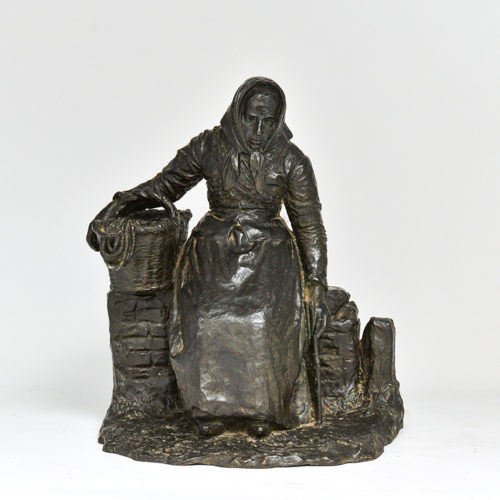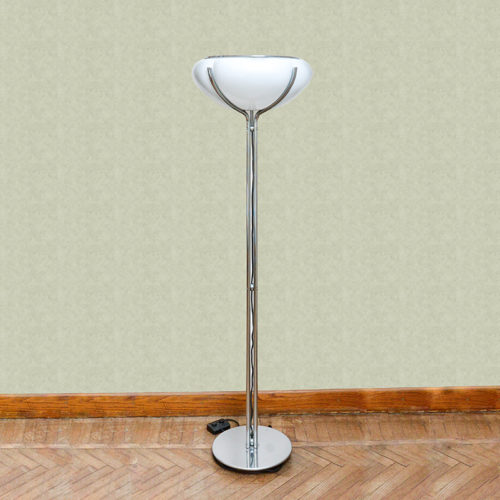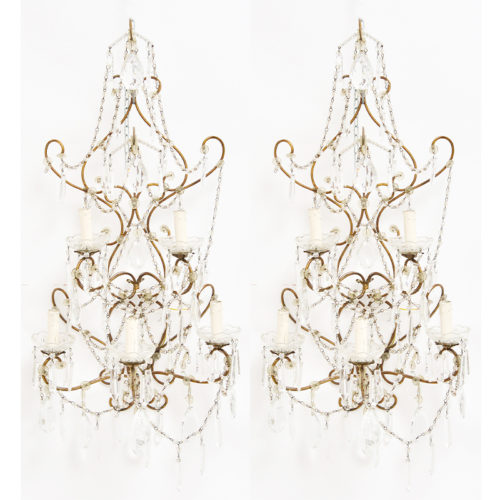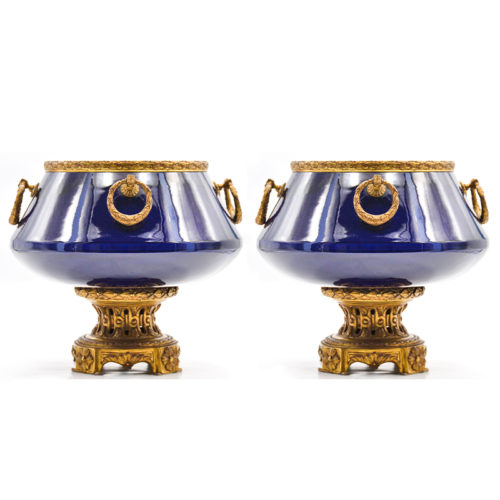"Old woman with basket "- Bronze dating back to the early 1900s
-
Out of stock
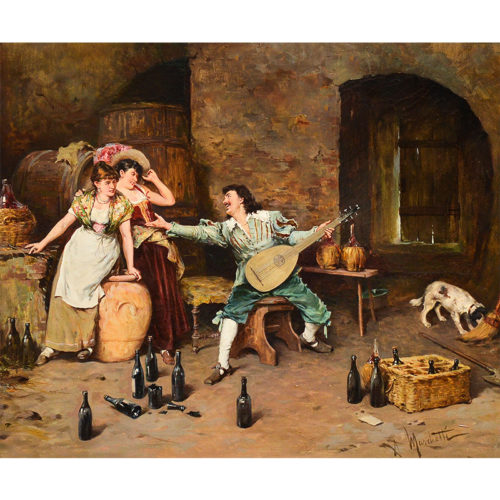 Period: Late 19th century Measures: In frame H 74 x L 85 x P 9 / Canvas H 50 x L 60 cm"Interior scene with characters" - Oil on canvas, signed on the lower right corner "Marchetti", dating back to the end of the 19th century, of beautiful quality and definition.
Period: Late 19th century Measures: In frame H 74 x L 85 x P 9 / Canvas H 50 x L 60 cm"Interior scene with characters" - Oil on canvas, signed on the lower right corner "Marchetti", dating back to the end of the 19th century, of beautiful quality and definition. -
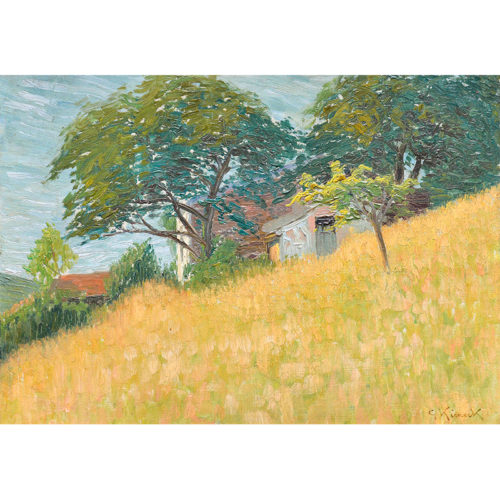 Period: 30s / 40s Measures: H 44 x L 55 x P 6 / Tablet H 26 x L 35 cm"Landscape" - Oil on tablet by Giorgio Kienerk (1869-1948). Signed on the lower right. The work was already sold in Martini auction in December 2011. KIENERK GIORGIO. He was born in Florence, in an ancient Tuscan family, on May 5, 1869. He studied with Adriano Cecioni, then, recommended by Telemaco Signorini, he dedicated himself not only to sculpture but also to painting. He formed, therefore, alongside Macchiaioli and made his debut very early, exhibiting six small landscapes at the Promotrice of Florence in 1888. He continued annually to present paintings and statues there. From 1891 to 1895 he followed the Divisionist school and painted, among other things, In riva all'Arno and Mattino sul mare. In 1897 he exhibited two large pastel female portraits at the Internationale of art and flowers in Florence and then oriented himself towards large figures, often with an allegorical meaning. In 1898 he appeared in Turin with Dolore. Then he participated in the Venetian Biennials with La vergognosa (1899), Il Silenza (1901), the Portrait of Irma Gramatica, pastel (1903), Sera, drawing (1905). He then came to the main Italian and foreign exhibitions in Brussels, Munich, Vienna, London, Saint Louis, Buenos Aires. With his scratched, borderless drawings, he has collaborated in magazines and newspapers (La Fiammetta, No-vissima, L'Italia ride, La Domenica dell'Avanti, La Liguria ligure, Numero, Gil Blas and Cocoricò dì Parigi). In 1905 he was appointed director of the civic painting school of Pavia. In the early period Pavia was particularly interested in sculpture, especially bronze plaques, a genre that he cultivated for a long time. After 1913, thanks to the experience acquired with the studies on Divisionism and mindful of the research of colors and light of the early years, he returned to deal with landscape and from then until his death the campaign was a continuous source of inspiration, especially after 1920 when he started working in Fauglia, on the Pisan hills (The washerwomen, Under the olive tree, In the shadow of the Carob tree, Dusty road). The portraits also belong to his last production (Portrait of the Marquis Quaratesi). In 1922 he exhibited in Florence at the Fiorentina Spring and until 1936 several times in Pavia. In 1936, finishing his teaching at the school of painting, many works were purchased by the Municipality of Pavia and are located in the museum of that city. From 1937 to 1943 he lived in Florence, exhibiting in various solo shows in Florence itself and also in Lucca and Livorno. In 1947 an exhibition of his works was opened at the Galleria Geri in Milan. Retiring to Fauglia with his family in 1943, he died in his villa in Poggio alla Farnia on February 15, 1948. His works can be found in the Modern Art Galleries of Venice, Florence, Lima (Peru) and in the Museum of Brussels. Many are in private collections in Pavia, Milan, where in the Turri Collection there is a Girl's Head, in Genoa, Florence. He engraved some drypoint plates.
Period: 30s / 40s Measures: H 44 x L 55 x P 6 / Tablet H 26 x L 35 cm"Landscape" - Oil on tablet by Giorgio Kienerk (1869-1948). Signed on the lower right. The work was already sold in Martini auction in December 2011. KIENERK GIORGIO. He was born in Florence, in an ancient Tuscan family, on May 5, 1869. He studied with Adriano Cecioni, then, recommended by Telemaco Signorini, he dedicated himself not only to sculpture but also to painting. He formed, therefore, alongside Macchiaioli and made his debut very early, exhibiting six small landscapes at the Promotrice of Florence in 1888. He continued annually to present paintings and statues there. From 1891 to 1895 he followed the Divisionist school and painted, among other things, In riva all'Arno and Mattino sul mare. In 1897 he exhibited two large pastel female portraits at the Internationale of art and flowers in Florence and then oriented himself towards large figures, often with an allegorical meaning. In 1898 he appeared in Turin with Dolore. Then he participated in the Venetian Biennials with La vergognosa (1899), Il Silenza (1901), the Portrait of Irma Gramatica, pastel (1903), Sera, drawing (1905). He then came to the main Italian and foreign exhibitions in Brussels, Munich, Vienna, London, Saint Louis, Buenos Aires. With his scratched, borderless drawings, he has collaborated in magazines and newspapers (La Fiammetta, No-vissima, L'Italia ride, La Domenica dell'Avanti, La Liguria ligure, Numero, Gil Blas and Cocoricò dì Parigi). In 1905 he was appointed director of the civic painting school of Pavia. In the early period Pavia was particularly interested in sculpture, especially bronze plaques, a genre that he cultivated for a long time. After 1913, thanks to the experience acquired with the studies on Divisionism and mindful of the research of colors and light of the early years, he returned to deal with landscape and from then until his death the campaign was a continuous source of inspiration, especially after 1920 when he started working in Fauglia, on the Pisan hills (The washerwomen, Under the olive tree, In the shadow of the Carob tree, Dusty road). The portraits also belong to his last production (Portrait of the Marquis Quaratesi). In 1922 he exhibited in Florence at the Fiorentina Spring and until 1936 several times in Pavia. In 1936, finishing his teaching at the school of painting, many works were purchased by the Municipality of Pavia and are located in the museum of that city. From 1937 to 1943 he lived in Florence, exhibiting in various solo shows in Florence itself and also in Lucca and Livorno. In 1947 an exhibition of his works was opened at the Galleria Geri in Milan. Retiring to Fauglia with his family in 1943, he died in his villa in Poggio alla Farnia on February 15, 1948. His works can be found in the Modern Art Galleries of Venice, Florence, Lima (Peru) and in the Museum of Brussels. Many are in private collections in Pavia, Milan, where in the Turri Collection there is a Girl's Head, in Genoa, Florence. He engraved some drypoint plates. -
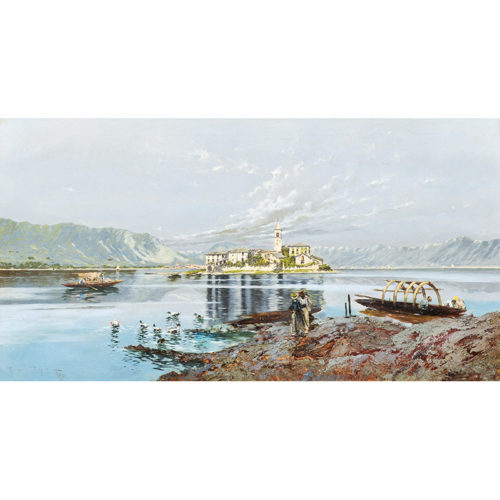 Period: 1896 Measurements: In frame H 87 x L 143 / Canvas H 65 x L 121 cm"Lake Maggiore" - Large oil painting on canvas by Riccardo Pellegrini (1863-1934), depicting the Fishermen's Island seen from a coast. Restored, with contemporary frames. PELLEGRINI RICCARDO. Born in Milan on 11 March 1863, died in Crescenzago (Mi) on 31 March 1934. He studied in his city, then in Rome, and in Naples with Domenico Morelli. He travelled to Spain, England and France to deepen his artistic knowledge. In 1912 he won the Muller house competition in London for the illustrations of the Gil Blas of Le Sage. Then the illustrations for "Don Quixote" were commissioned. The main magazines in Europe collaborated with him. He rarely exhibited in Italy, but always with success. His sketch Malta is located in the Berlin Art Museum; La ridda, in the Gofort Museum in Stuttgart; The kiss of sun, in the Goupil Gallery in Paris. The drawings made for the "Gil Blas" were collected in a room dedicated to the Pilgrims in the Glasgow Museum. The Bottega di Poesia exhibition held in Milan in 1926 featured: A carpet market in Spain; Winter quiet; Sun of July; One August morning in Toledo; Valencian Sea; The spouses. Other works: Spanish flower market, in the R.O. collection of Rome, one of his best works; Villereccia party, in the Rovelli collection of Milan; The antiquarian, in the Ruffini collection in Milan; In the market (Xeres); Sur la promenade des Anglais; Notes of Spain; Remembrance of Seville; I remember my country; El picador; El primer espada; View of Seville; Spanish types; A bullfighter.
Period: 1896 Measurements: In frame H 87 x L 143 / Canvas H 65 x L 121 cm"Lake Maggiore" - Large oil painting on canvas by Riccardo Pellegrini (1863-1934), depicting the Fishermen's Island seen from a coast. Restored, with contemporary frames. PELLEGRINI RICCARDO. Born in Milan on 11 March 1863, died in Crescenzago (Mi) on 31 March 1934. He studied in his city, then in Rome, and in Naples with Domenico Morelli. He travelled to Spain, England and France to deepen his artistic knowledge. In 1912 he won the Muller house competition in London for the illustrations of the Gil Blas of Le Sage. Then the illustrations for "Don Quixote" were commissioned. The main magazines in Europe collaborated with him. He rarely exhibited in Italy, but always with success. His sketch Malta is located in the Berlin Art Museum; La ridda, in the Gofort Museum in Stuttgart; The kiss of sun, in the Goupil Gallery in Paris. The drawings made for the "Gil Blas" were collected in a room dedicated to the Pilgrims in the Glasgow Museum. The Bottega di Poesia exhibition held in Milan in 1926 featured: A carpet market in Spain; Winter quiet; Sun of July; One August morning in Toledo; Valencian Sea; The spouses. Other works: Spanish flower market, in the R.O. collection of Rome, one of his best works; Villereccia party, in the Rovelli collection of Milan; The antiquarian, in the Ruffini collection in Milan; In the market (Xeres); Sur la promenade des Anglais; Notes of Spain; Remembrance of Seville; I remember my country; El picador; El primer espada; View of Seville; Spanish types; A bullfighter. -
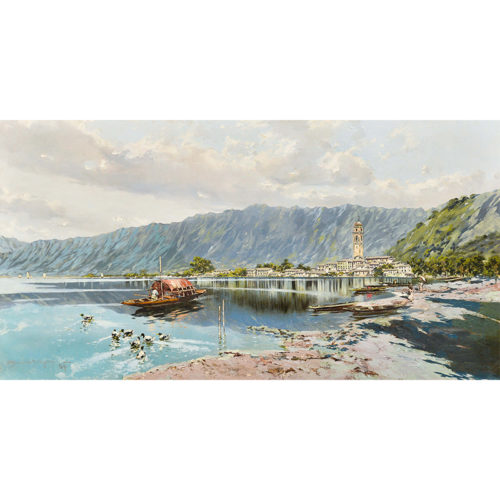 Period: 1896 Measurements: In frame H 87 x L 143 / Canvas H 65 x L 121 cm"Lago Maggiore" - Large oil painting on canvas by Riccardo Pellegrini (1863-1934), depicting a landscape on the shores of Lake Maggiore. Restored, with coeval frame. PELLEGRINI RICCARDO. Born in Milan on 11 March 1863, died in Crescenzago (Mi) on 31 March 1934. He studied in his city, then in Rome, and in Naples with Domenico Morelli. He travelled to Spain, England and France to deepen his artistic knowledge. In 1912 he won the Muller house competition in London for the illustrations of the Gil Blas of Le Sage. Then the illustrations for "Don Quixote" were commissioned. The main magazines in Europe collaborated with him. He rarely exhibited in Italy, but when he did it had always success. His sketch Malta is located in the Berlin Art Museum; La ridda, in the Gofort Museum in Stuttgart; The kiss of sun, in the Goupil Gallery in Paris. The drawings made for the "Gil Blas" were collected in a room dedicated to the Pilgrims in the Glasgow Museum. The Bottega di Poesia exhibition held in Milan in 1926 featured: A carpet market in Spain; Winter quiet; Sun of July; One August morning in Toledo; Valencian Sea; The spouses. Other works: Spanish flower market, in the R.O. collection of Rome, one of his best works; Villereccia party, in the Rovelli collection of Milan; The antiquarian, in the Ruffini collection in Milan; In the market (Xeres); Sur la promenade des Anglais; Notes of Spain; Remembrance of Seville; I remember my country; El picador; El primer espada; View of Seville; Spanish types; A bullfighter.
Period: 1896 Measurements: In frame H 87 x L 143 / Canvas H 65 x L 121 cm"Lago Maggiore" - Large oil painting on canvas by Riccardo Pellegrini (1863-1934), depicting a landscape on the shores of Lake Maggiore. Restored, with coeval frame. PELLEGRINI RICCARDO. Born in Milan on 11 March 1863, died in Crescenzago (Mi) on 31 March 1934. He studied in his city, then in Rome, and in Naples with Domenico Morelli. He travelled to Spain, England and France to deepen his artistic knowledge. In 1912 he won the Muller house competition in London for the illustrations of the Gil Blas of Le Sage. Then the illustrations for "Don Quixote" were commissioned. The main magazines in Europe collaborated with him. He rarely exhibited in Italy, but when he did it had always success. His sketch Malta is located in the Berlin Art Museum; La ridda, in the Gofort Museum in Stuttgart; The kiss of sun, in the Goupil Gallery in Paris. The drawings made for the "Gil Blas" were collected in a room dedicated to the Pilgrims in the Glasgow Museum. The Bottega di Poesia exhibition held in Milan in 1926 featured: A carpet market in Spain; Winter quiet; Sun of July; One August morning in Toledo; Valencian Sea; The spouses. Other works: Spanish flower market, in the R.O. collection of Rome, one of his best works; Villereccia party, in the Rovelli collection of Milan; The antiquarian, in the Ruffini collection in Milan; In the market (Xeres); Sur la promenade des Anglais; Notes of Spain; Remembrance of Seville; I remember my country; El picador; El primer espada; View of Seville; Spanish types; A bullfighter. -
Out of stock
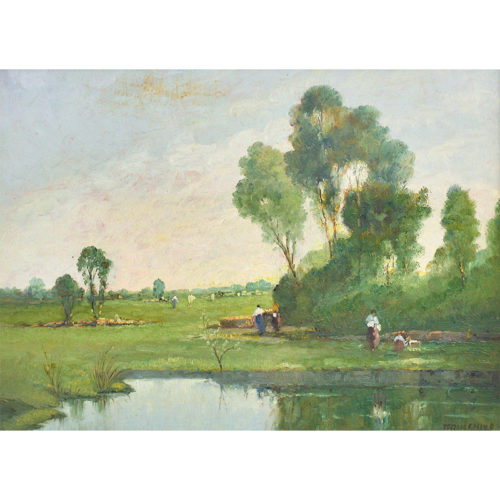 Period: 1940s Measurements: In frame H 45 x W 56.5 x D 6 / Painting H 27.5 x L 37 cm"Landscape" - Oil on tablet by Telesforo Franchino (Treviso 1885 - 1968 Turin, dating back to the 1940s There is no particular biographical information on the painter, however his pictorial testimony remains. He used to paint mountain or simple countryside landscapes. distinctive and very suggestive feature.
Period: 1940s Measurements: In frame H 45 x W 56.5 x D 6 / Painting H 27.5 x L 37 cm"Landscape" - Oil on tablet by Telesforo Franchino (Treviso 1885 - 1968 Turin, dating back to the 1940s There is no particular biographical information on the painter, however his pictorial testimony remains. He used to paint mountain or simple countryside landscapes. distinctive and very suggestive feature. -
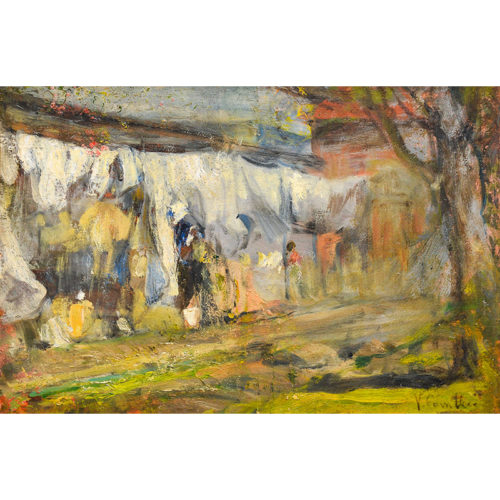 Period: Early 1900s Measurements: In frame H 41 x L 53.5 / Tablet H 24.5 x L 36 cm"Laundry in the sun" - Oil on tablet by Vittorio Cavalleri (1860 - 1938), dating back to the early 1900s. The work is signed in the lower right corner by the author, a Piedmontese painter, son of a cloth merchant, was started by his father for the family's commercial activity. CAVALLERI VITTORIO. Born in Turin in 1860, died in Turin on May 22, 1938. He attended the Accademia Albertina, a pupil of Gamba, Gilardi and Gastaldi. Landscape painter and portraitist, with a robust color, with a strong personality. In 1885 he participated for the first time in the Turin Promoter Exhibition with "Abandoned Hoes" and then frequently exhibited at the Turin exhibitions and the main Italian exhibitions, including the Venice Internationals, until 1925. He also painted sacred subjects, and in the Sanctuary of Oropa found three of his great paintings representing Peace; War and the faithful. Other works: Sad winter; Tonio the gallant; The grandmother and Alpine Flora, preserved in the Civic Museum of Turin; Mountain hospitality in the Marangoni Museum in Udine; In spring; Cemetery flowers; Love story; Empiricism; Ave Maria; Summer in the hills; In the shadow; Baleful Aurora; At home forced; Tribolo; First treasures; Portrait of a man; Domus Aurea; The drowned; Portrait of the Duke of Aosta, in the Gallery of the Order of the Garter at the Court of King Edward of England; Portrait of the mother, in the artist's studio; the Self-portrait, owned by Botto of Milan; Supplizi in the Cartotti collection of Lessona; Ray of sunshine, with Mr. Vittorio Vacchieri; Assalita, Ferrino property; A sunbath, in the Vignolo di Torino collection and the Portrait of Mrs. Pelizzone. Many of his works exist in the Colongo collection in Biella and among them: The shadow; The washerwoman; In adoration; At the source; Theater interior; Sleeping girl. His pupils were: Giuseppe Moreno, Domenico Motta, E. Nicolello, Ans. Priest.
Period: Early 1900s Measurements: In frame H 41 x L 53.5 / Tablet H 24.5 x L 36 cm"Laundry in the sun" - Oil on tablet by Vittorio Cavalleri (1860 - 1938), dating back to the early 1900s. The work is signed in the lower right corner by the author, a Piedmontese painter, son of a cloth merchant, was started by his father for the family's commercial activity. CAVALLERI VITTORIO. Born in Turin in 1860, died in Turin on May 22, 1938. He attended the Accademia Albertina, a pupil of Gamba, Gilardi and Gastaldi. Landscape painter and portraitist, with a robust color, with a strong personality. In 1885 he participated for the first time in the Turin Promoter Exhibition with "Abandoned Hoes" and then frequently exhibited at the Turin exhibitions and the main Italian exhibitions, including the Venice Internationals, until 1925. He also painted sacred subjects, and in the Sanctuary of Oropa found three of his great paintings representing Peace; War and the faithful. Other works: Sad winter; Tonio the gallant; The grandmother and Alpine Flora, preserved in the Civic Museum of Turin; Mountain hospitality in the Marangoni Museum in Udine; In spring; Cemetery flowers; Love story; Empiricism; Ave Maria; Summer in the hills; In the shadow; Baleful Aurora; At home forced; Tribolo; First treasures; Portrait of a man; Domus Aurea; The drowned; Portrait of the Duke of Aosta, in the Gallery of the Order of the Garter at the Court of King Edward of England; Portrait of the mother, in the artist's studio; the Self-portrait, owned by Botto of Milan; Supplizi in the Cartotti collection of Lessona; Ray of sunshine, with Mr. Vittorio Vacchieri; Assalita, Ferrino property; A sunbath, in the Vignolo di Torino collection and the Portrait of Mrs. Pelizzone. Many of his works exist in the Colongo collection in Biella and among them: The shadow; The washerwoman; In adoration; At the source; Theater interior; Sleeping girl. His pupils were: Giuseppe Moreno, Domenico Motta, E. Nicolello, Ans. Priest. -
Out of stock
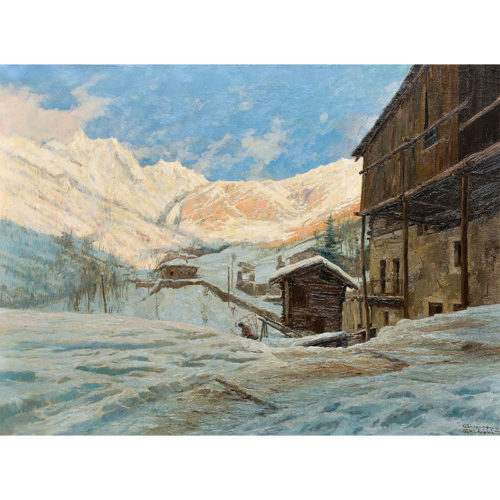 Period: about 1920 Measurements: In frame H 83 x L 102 x P 7 / Table H 61 x L 80.5 cm"Valle d'Aosta landscape with huts" - Oil on panel by Giuseppe Gheduzzi (1889-1957). Born in Crespellano (Bologna) on May 12, 1889, he lived in Turin where he died on May 21, 1957. He learned the basics of art from his father Ugo, then attended the Accademia Albertina, a pupil of Andrea Marchisio and Paolo Gaidano, for only three years, because he was forced to help his father in the scenography works. He was a skilled landscape painter. It began in Vignola in 1907 with an alpine landscape. He held several solo exhibitions and took part in many exhibitions. He participated in the events of the Promotrice alle Belle Arti in Turin for twenty consecutive years (awarded with a gold medal) and in the circle of artists in Turin. Solo exhibitions were held at the Bolzani Gallery in Milan; at the Galleria A. Garabello in Biella; at Galleri Fogliato and Lombardi Gallery in Turin.
Period: about 1920 Measurements: In frame H 83 x L 102 x P 7 / Table H 61 x L 80.5 cm"Valle d'Aosta landscape with huts" - Oil on panel by Giuseppe Gheduzzi (1889-1957). Born in Crespellano (Bologna) on May 12, 1889, he lived in Turin where he died on May 21, 1957. He learned the basics of art from his father Ugo, then attended the Accademia Albertina, a pupil of Andrea Marchisio and Paolo Gaidano, for only three years, because he was forced to help his father in the scenography works. He was a skilled landscape painter. It began in Vignola in 1907 with an alpine landscape. He held several solo exhibitions and took part in many exhibitions. He participated in the events of the Promotrice alle Belle Arti in Turin for twenty consecutive years (awarded with a gold medal) and in the circle of artists in Turin. Solo exhibitions were held at the Bolzani Gallery in Milan; at the Galleria A. Garabello in Biella; at Galleri Fogliato and Lombardi Gallery in Turin. -
Out of stock
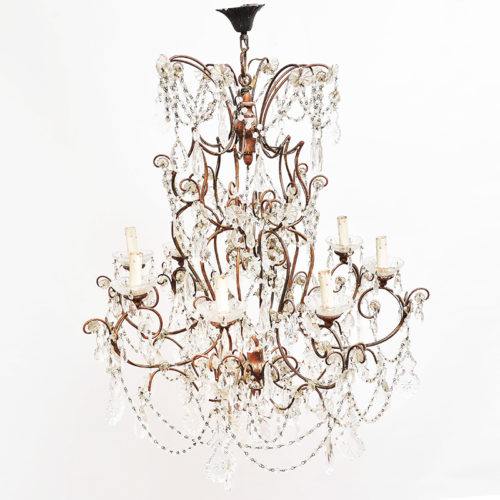 Period: 1940s Measurements: H 87 x Ø 75 cmDrop chandelier with volute structure in iron rod, and eight light points, dating back to the 1940s
Period: 1940s Measurements: H 87 x Ø 75 cmDrop chandelier with volute structure in iron rod, and eight light points, dating back to the 1940s
